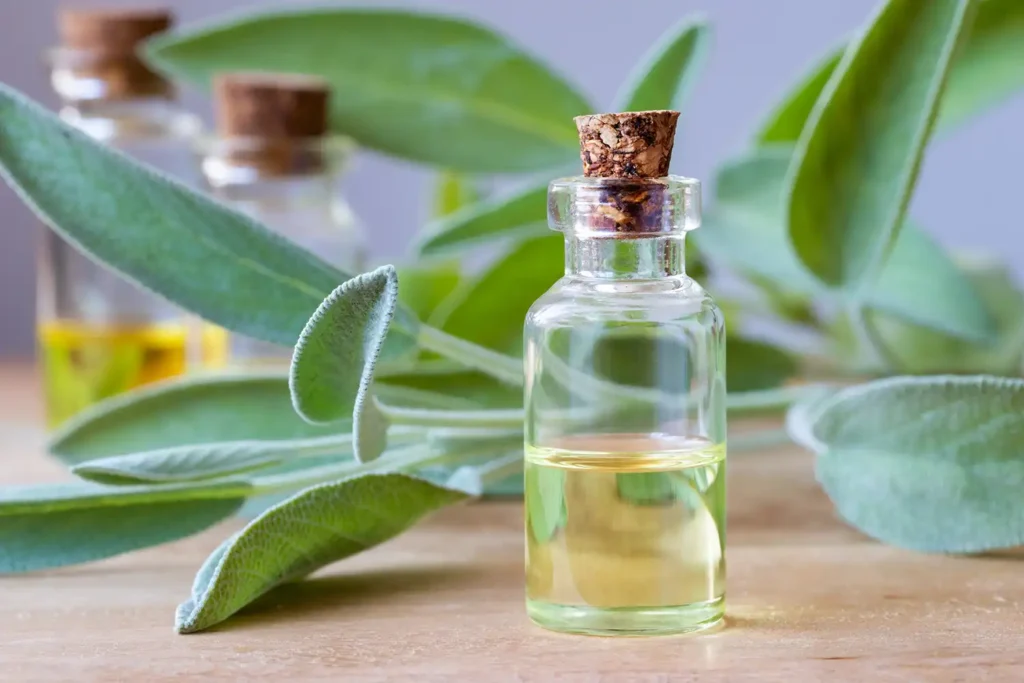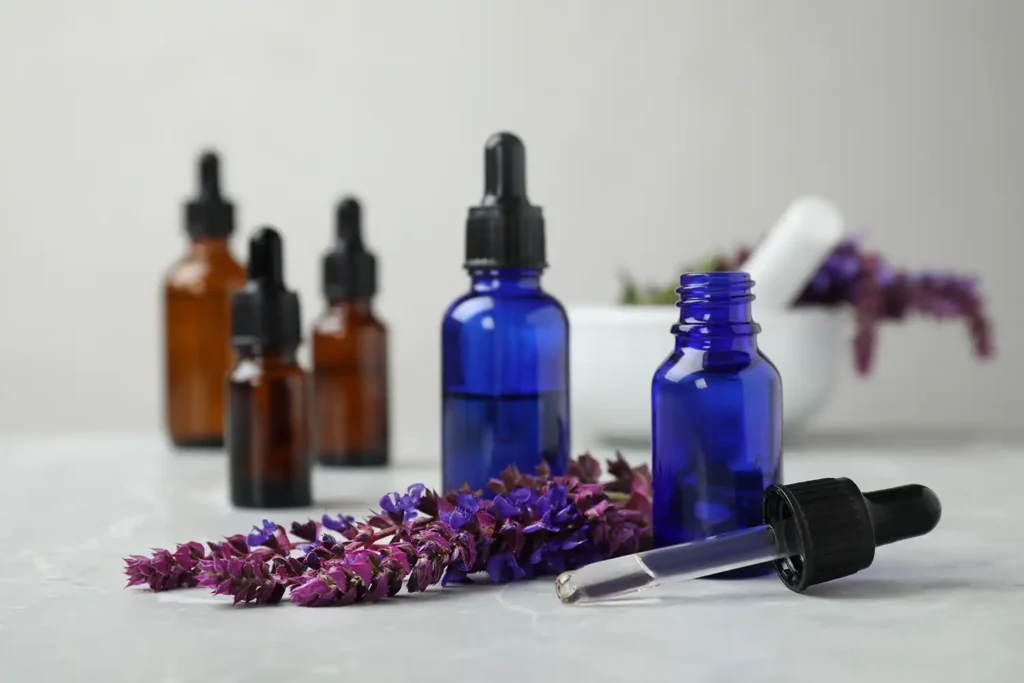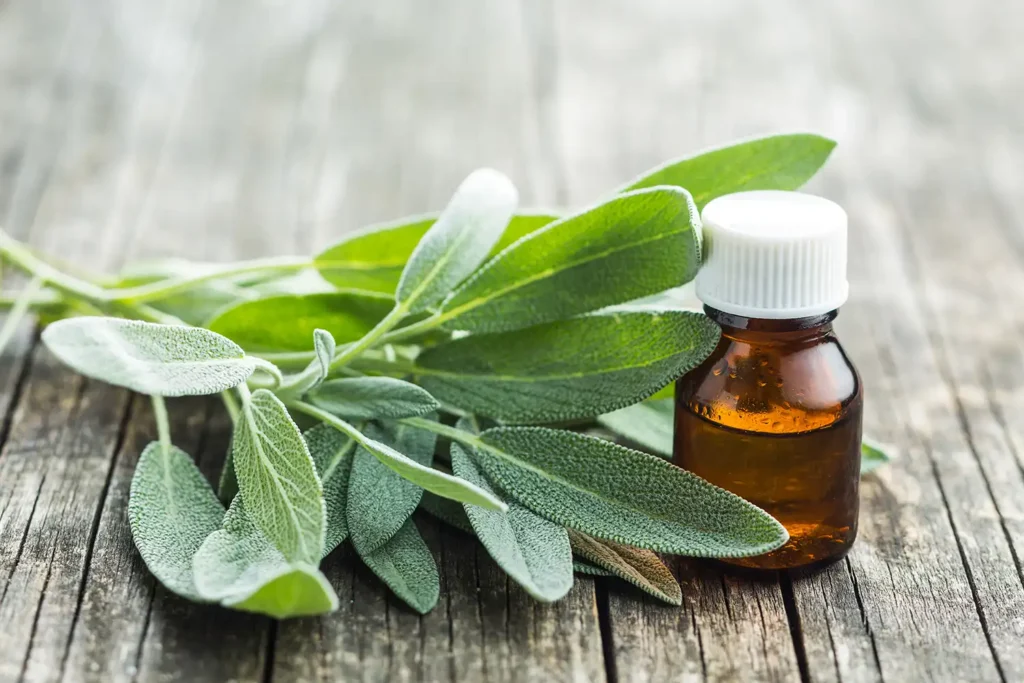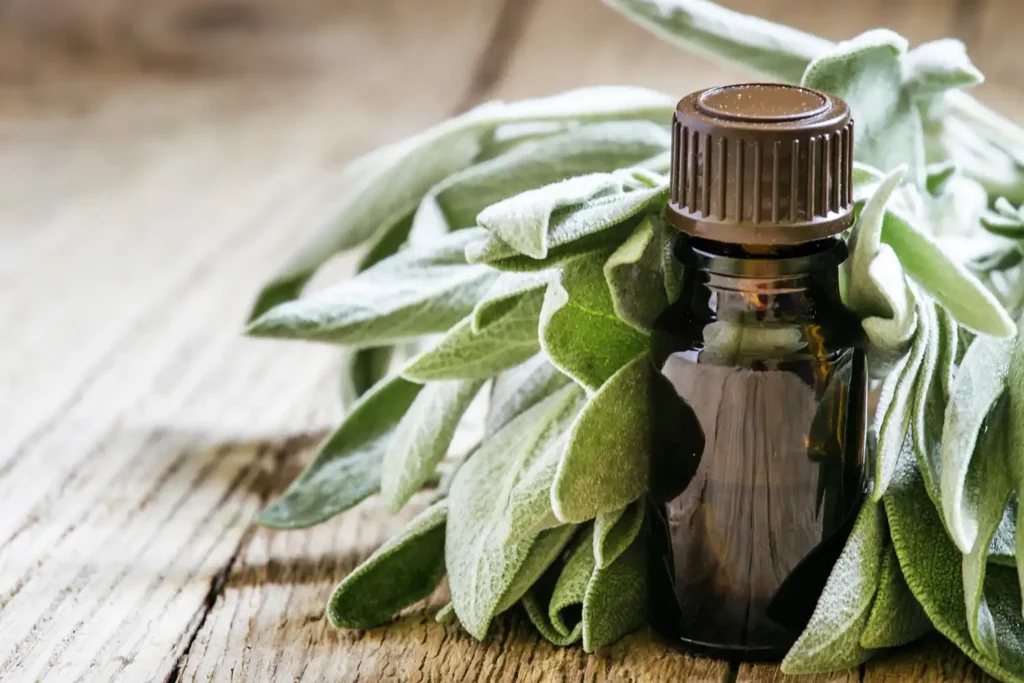Introduction to Sage Essential Oil
Sage essential oil has been used for centuries to treat various conditions and ailments. It has been used to soothe inflammation, alleviate stress, and improve overall mental and physical health. In recent years, the benefits of this fantastic oil have become more widely known and appreciated. It has become a popular ingredient in aromatherapy and skincare products, but of all the oils, what makes this unique, and how can you use it to unlock its benefits?
What is Sage Oil used for?
People have used it for a lot of things. It has been used for a long time as an ingredient in perfumes and as a medicine. The Roman and Ancient Greek societies used the soothing effect of Sage extensively for wound infections, bacterial infections of the throat, and skin inflammation. While marching across Southern Europe, it became indispensable to relax muscles when they set up camp. It is easy to plant the seeds, and as the herb grows very quickly, it was ready for the next regiment to harvest to use on their sore muscles and improve their general well-being.
It is well known for its antioxidant, anti-inflammatory, and antimicrobial properties. It is commonly used to cope with many conditions, from sore throats to easing menopausal symptoms.
When used in a diffuser or burner, it is also used in aromatherapy for its calming and soothing properties. When the aroma molecules come into contact with the olfactory system, it is now shown to help stimulate dopamine activities and improve mental function.
As you will read further, Sage oil also has some desirable qualities in skincare and hair products.
What is the difference between Sage Oil and Clary Sage Essential Oil?
Sage essential oil is a pale yellow colour produced by steam distillation of dried sage leaves. The specific variety is the perennial herb Salvia officinalis. This is a common garden herb used in cooking because of its strong aroma (sage and onion stuffing is hugely popular in the UK). Salvia Officinalis also has several other common names, such as Garden, True, and Common Sage.
Clary sage essential oil is made by steam distillation of the dried leaves of Salvia sclarea (Clary sage plant). It is also used in food and beverages.
However, even though they are both referred to as Sage, the two should not be considered swaps for each other because they are different in many ways. It is best always to check the INCI to ensure you have the right one.
So, to avoid doubt, Sage essential oil is different from Clary sage essential oil… 🙂
Health Benefits of Using Sage Essential Oil
Common Sage has been used for centuries to treat many different ailments. Native Americans traditionally used the herb in food as an antibacterial agent because of its ability to target bacteria cells such as E. Coli. Even now, it is frequently used in everyday remedies to treat general infections caused by bacteria.
It also has an excellent ability to reduce inflammation and pain. This is useful in localised balms that can be applied to knees and elbows, for example. Blending it with Lavender essential oil has a synergistic effect of boosting these properties. Professional aromatherapists may combine it with Plai essential oil in a muscle balm, making it a very effective analgesic balm.
Sage oil is calming when inhaled from a diffuser and can be very therapeutic for reducing stress levels. A small amount could be blended with Chamomile oil to make a good sleep aid in the bedroom. It is now well known that reducing stress levels and a good night’s sleep improve overall emotional well-being.
What does Sage Oil do for the body?
Sage is a well-known strong antimicrobial agent that can help protect against harmful bacteria, viruses and fungi.
It takes inflammation down quite effectively, and this also helps to ease discomfort.
Because it is a rich source of antioxidants, it helps protect the body from free radicals. It also helps the body’s overall health. Sage is also excellent in skincare products.
Traditionally, qualified aromatherapists have used Sage for women coping with irregular menstrual cycles, hot flashes and other menopausal symptoms.
The herb has a good reputation for aiding digestion. The classic English sage and onion stuffing is a good example of this. However, we do not recommend taking Sage essential oil internally as this can be dangerous – it is much more concentrated than the fresh or culinary dried herb.
Is Sage Oil good for wrinkles?
Yes, but this deserves more explanation; Sage oil contains powerful free radical scavengers like Rosmarinic Acid and Carnosic Acid. These antioxidants help reduce free radical damage by mopping up the unpaired electrons that cause wrinkles. Studies using Rosmarinic Acid have shown it to boost collagen production in the skin, thus potentially also helping to reduce wrinkles and fine lines.
In addition, it has natural astringent properties that can help reduce wrinkles, potentially helping loose skin to firm up. What’s not to like about that?
Is Sage Essential Oil good for hair and skin?
Absolutely! You have already read about the potential of boosting collagen production and reducing wrinkles, but it does even more!
It also has a wonderful ability to help those coping with muscular discomfort. When blended into a massage oil with Rosemary and Eucalyptus, it is excellent to use after a gym session or for a pre-workout warm-up. It may help to reduce muscle discomfort and stop muscles from stiffening up later in the day.
Similarly, it can help those coping with pain, swelling, and stiffness associated with arthritis. Aromatherapists may combine it with Peppermint oil if the arthritic pain feels hot and blend it with Ginger oil if the arthritis feels cold. Obviously, make sure to get these the right way around!
You can make a hot oil hair treatment by adding a couple of drops of Sage with a few drops of other essential oils like Rosewood and Geranium to a cup of Camellia Seed oil, making your hair more flexible and hydrated. Put this blend into a small bottle and stand it in a mug of hot water for a few minutes to warm it up, and then apply it to your scalp. This helps to balance sebum production in the scalp. Balancing oil production in the scalp can help both dry hair and greasy hair to be more manageable.

How to Use Sage Essential Oil in Aromatherapy
There are many aromatherapy applications, and Sage Oil’s main functional chemical components are Camphor, α-Thujone, β-Thujone, 1,8-Cineole, α-Pinene, and Borneol.
Camphor is a terpene that is known to be a good antiseptic as well as an anti-inflammatory. It’s easy to see how this is effective as a decongestant and a cough suppressant when used in a diffuser.
Alpha-Thujone is a chemical compound known for its anti-inflammatory properties and a stimulant of the CNS (Central Nervous System). All essential oils need to be respected and used carefully, but this is very important with Sage oil because of this component.
Beta-Thujone is known for its anti-microbial properties and also stimulates the CNS.
1,8-Cineole is another terpene compound that has antifungal effects. It’s anti-microbial, analgesic, antiviral and may reduce inflammation. There are so many used for this, but the first one that springs to mind is using Sage oil in a foot cream for its antifungal effects to combat athlete’s foot and ease the aches and pains of tired feet.
Alpha-Pinene is another terpene that reduces inflammation and is also an antiseptic. You can see how potent it is with this layering of terpenes. This particular terpene is also an expectorant and a bronchodilator. It is excellent to use in the diffuser to help ease chesty coughs and even mild asthma (you should also report your asthma to your doctor). Another way to use this is to make a balm containing Frankincense, which will help you breathe easier.
Borneol is one of Sage Oil’s monoterpenes, and interesting studies have identified Borneol as a messenger that facilitates the delivery of other drugs to specific sites and harmonises their effects.
The chemical composition of essential oils can vary depending on the type of plant, the growing conditions, and the extraction method used. For example, many essential oils can have a very different chemical composition from batch to batch.
Salvia Officinalis (Sage Oil) has been shown to be an antioxidant, antibacterial, and anti-inflammatory and is being researched for anti-tumour potential. Research is now directed towards using the oil’s molecular components to develop novel new drugs for diabetes and Alzheimer’s.
It has good antidepressant effects and has been particularly helpful with depression in menopause.
Research has shown that Sage Oil enhances cognitive performance in healthy subjects and patients with dementia or cognitive impairment.
It can also be used to treat digestive problems. It has a calming effect on the digestive system and can help to reduce gas, bloating, and stomach cramps. This can help with conditions like Irritable Bowel Syndrome (IBS) and Crohn’s disease.
In addition, it can be used to treat skin problems such as eczema and psoriasis. Its ability to reduce inflammation helps to reduce inflammation to start the healing process.
You can see why Sage is essential to an aromatherapist’s tool kit!
What is Sage Essential Oil good for?
The fresh herb and essential oil have been used for thousands of years for their medicinal and therapeutic properties. It has been used to help with ailments ranging from muscle aches and headaches to digestive and skin problems. It has even been used as an insect repellent. Today, Sage essential oil is gaining popularity for its potential to improve mental and emotional health.
Sage essential oil is also a powerful antioxidant. This means it can help protect the body’s cells from damage caused by free radicals, which could otherwise lead to diseases and premature ageing. It can also help to reduce stress by providing a calming effect, and it has even been used to treat insomnia and anxiety.
When used topically in oil blends, creams, lotions and gels, it can be used to help skin conditions like psoriasis. It can also be used to soothe minor burns and insect bites. Make a simple base gel formulation and combine the Sage oil with Chamomile essential oil.
It’s also a great way to boost your immune system as well as reduce the appearance of wrinkles and age spots.


How to Make DIY Beauty Products with Sage Essential Oil
There are many ways it can be used in beauty products, and a very popular one in spas is to use it in wraps for cellulitis. A safe amount is added to a basic gel formulation and applied to the client, who is then covered in a foil blanket for a while. Sage Oil is lipolytic, which means it helps to break down fats and helps to release fatty acids.
It is also antiseptic and has anti-fungal properties. You can use these attributes in a gel or, even better, in a cream you have made yourself. You can easily create a multifunctional foot cream for fungal infections to sort out athlete’s foot for good and remove hard skin.
Be aware, though, that it has several ketones (the alpha and beta thujone), and if it is used in excess, it can irritate the nervous system. Always use safe guidelines.
Can Sage Oil be applied directly to the skin?
We don’t recommend applying Sage Oil directly to your skin. Used this way, there is too much risk of localised skin irritation; it is also unnecessary. It’s wonderfully effective even when diluted in a carrier oil, gel or cream base. Even then, it should not be used on broken skin. It can also be added to a carrier oil before being used in a bath. Try using a drop or two into a diffuser to reduce anxiety and stress – it brings a wonderful sense of calm.
Common Uses for Sage Oil
As you can see, Sage offers a variety of health benefits, BUT it’s always important to use the oil correctly. Before use, it should be diluted with a carrier oil such as jojoba, almond, or coconut. You can also add a few drops to a diffuser to help with stress and anxiety.
Where do you apply Sage Oil?
It will mainly be applied to your skin, but only use it directly after ensuring it has been diluted safely. Use a carrier oil for this, or it can be added to gels, creams and lotions that you have made.
This also applies to your scalp, where it can be very beneficial for soothing irritation, whether from longer-term scalp dermatitis or from having used some hair product that didn’t suit you. It is very moisturising for the scalp, and this also helps to stop dandruff and can reduce hair loss.
If added to a shampoo you have made, it will cleanse your scalp very well, removing greasiness that makes your hair feel heavy and lank.
Another primary use of Sage Oil is aromatherapy. Its antibacterial properties can help with nose and throat infections when used in a diffuser or nebuliser. This also helps to reduce sinusitis, coughs and colds, and other situations where phlegm can build up and cause congested breathing.
Diffusing in a burner or nebuliser increases relaxation whilst giving improved mental clarity. Inhaling Sage oil has been shown to lower blood pressure and reduce anxiety.
It has a reputation for regulating and helping to reduce menstrual cramps. It can smooth out mood swings and related nausea, headaches, and tiredness. However, this must be used carefully because the oil is an emmenagogue that can stimulate the uterine muscles. That is why pregnant women should not use it.

Potential Side Effects of Using Sage Essential Oil
Pregnant women are advised not to use Sage Oil without professional advice from a qualified aromatherapist because, when used in high amounts, it can cause uterine contractions. However, some people can be more sensitive to it, so it is suggested that nursing mothers do not use it without professional advice. It is also not recommended to use this oil on someone known to be living with an epilepsy diagnosis.
Looking After Your Sage Oil
You can take a few simple steps to get the most out of using Sage essential oil. You should ensure you are buying good quality essential oil. Many MLM companies sell extortionately overpriced products that often aren’t the best quality. A wide range is available on the market, so you’ll want to research and always check the INCI to ensure you get the right product.
Once you have your essential oil, you’ll want to use it safely and correctly. It is NOT to be used internally. Once again, some MLM companies use untrained staff who recommend taking the oils internally – another reason to avoid them! Sage Oil should always be used diluted in vegetable oil before being used. Once you have started your training, you’ll realise that selecting the right carrier oil can also enhance how the blend works for you.
Sage Oil should not be used during pregnancy or by nursing women. It should also be avoided by people who have epilepsy.
Be sure to store your oil, like other essential oils, in a cool, dark place, away from direct sunlight. This will help to keep them in the best condition possible and prevent them from losing potency.
Finally, keep the oil away from young children.
Final Thoughts
In conclusion, Sage essential oil has many potential health benefits and has been used in traditional and complementary medicine for centuries to treat various ailments. It has recently become more popular because of its use in skin care products and aromatherapy. It is thought to alleviate inflammation, reduce stress, and improve mental and physical health with an antidepressant-like effect. To unlock its full potential, you should understand its uses, many health benefits, and the differences between Sage and Clary Sage essential oils. Also, you can make DIY beauty products with Sage essential oil, using it to combat wrinkles and benefit scalp health. With an awareness of how to properly use Sage oil and its many benefits, you can unlock the potential of this fantastic oil.






